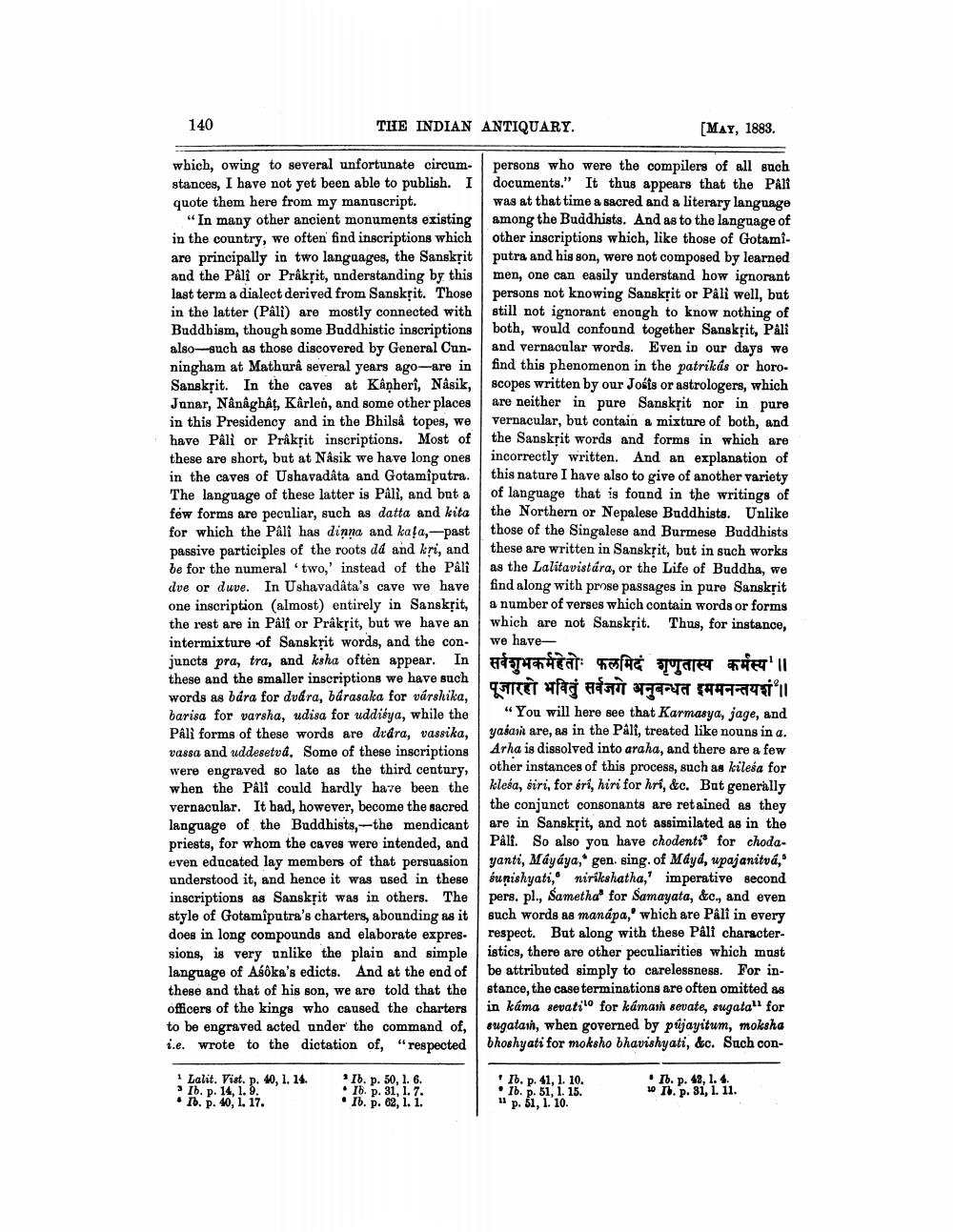________________
140
THE INDIAN ANTIQUARY.
[MAY, 1883.
which, owing to several unfortunate circumstances, I have not yet been able to publish. I quote them here from my manuscript.
"In many other ancient monuments existing in the country, we often find inscriptions which are principally in two languages, the Sanskpit and the Palî or Prakrit, anderstanding by this last term a dialect derived from Sanskrit. Those in the latter (Páli) are mostly connected with Buddhism, though some Buddhistic inscriptions also-such as those discovered by General Cunningham at Mathurâ several years ago-are in Sanskřit. In the caves at Kaņheri, Nasik, Janar, Nânâghâț, Kärles, and some other places in this Presidency and in the Bhilså topes, we have Pâli or Prakṣit inscriptions. Most of these are short, but at Nasik we have long ones in the caves of Ushavadata and Gotamiputra. The language of these latter is Pali, and but a few forms are peculiar, such as datta and kita
na necnliar, such as datta and kita for which the Pâli has dinna and kata, - past passive participles of the roots dd and ksi, and be for the numeral two,' instead of the Páli dve or duve. In Ushavadâta's cave we have one inscription (almost) entirely in Sanskrit, the rest are in Pali or Prakrit, but we have an intermixture of Sanskrit words, and the con- juncts pra, tra, and ksha often appear. In these and the smaller inscriptions we have such words as bára for dvära, bárasaka for vârshika, barisa for varsha, udisa for uddifya, while the Pali forms of these words are drára, vassika, vassa and uddesetvá. Some of these inscriptions were engraved so late as the third century, when the Pali could hardly have been the vernacular. It had, however, become the sacred language of the Buddhists,-the mendicant priests, for whom the caves were intended, and even educated lay members of that persuasion understood it, and hence it was used in these inscriptions as Sanskțit was in others. The style of Gotamiputra's charters, abounding as it does in long compounds and elaborate expres. sions, is very unlike the plain and simple language of Asoka's edicts. And at the end of these and that of his son, we are told that the officers of the kings who caused the charters to be engraved acted under the command of, i.e. wrote to the dictation of, "respected
persons who were the compilers of all such documents." It thus appears that the PAli was at that time a sacred and a literary language among the Buddhists. And as to the language of other inscriptions which, like those of Gotami. putra and his son, were not composed by learned men, one can easily understand how ignorant persons not knowing Sanskrit or Pali well, but still not ignorant enough to know nothing of both, would confound together Sanskrit, Pali and vernacular words. Even in our days we find this phenomenon in the patrikds or horo. scopes written by our Josis or astrologers, which are neither in pure Sanskrit nor in pure vernacular, but contain a mixture of both, and the Sanskrit words and forms in which are incorrectly written. And an explanation of this nature I have also to give of another variety of language that is found in the writings of the Northern or Nepalese Buddhists. Unlike those of the Singalese and Burmese Buddhists these are written in Sanskrit, but in such works as the Lalitavistára, or the Life of Buddha, we find along with prose passages in pure Sanskrit a number of verses which contain words or forms which are not Sanskrit. Thus, for instance, we have सर्वशुभकर्महेतोः फलमिदं गणतास्य कर्मस्य ।। पूजारहो भवितुं सर्वजगे अनुबन्धत इममनन्तयशं।
"You will here see that Karmasya, jage, and yasan are, as in the Pali, treated like nouns in a. Arha is dissolved into araha, and there are a few other instances of this process, such as kilesa for klesa, siri, for éri, hiri for hri, &c. Bat generally the conjunct consonants are retained as they are in Sanskrit, and not assimilated as in the Páli. So also you have chodenti for choda. yanti, Máyáya,' gen. sing. of Máyd, upajanitvá, éunishyati, niríkshatha,' imperative second pers. pl., Sametha for Samayata, &c., and even such words as manápa,' which are Pali in every respect. But along with these Páli characteristics, there are other peculiarities which must be attributed simply to carelessness. For instance, the case terminations are often omitted as in káma sevatit for káman sevate, sugata" for sugatan, when governed by pújayitum, moksha bhoshyati for moksho bhavishyati, &c. Such con
Lalit. Vist. p. 40, 1. 14.
Ib. p. 14, 1. 9. • Ib. p. 40, 1. 17.
* Ib. p. 50, 1. 6. • Ib. p. 31, 1.7. • Ib. p. 62, 1. 1.
Ib. p. 41, 1. 10. . Ib. p. 51, 1. 15. 11 p. 51, 1. 10.
Ib. p. 43, 1. 4. 10 I. p. 31, 1. 11.




